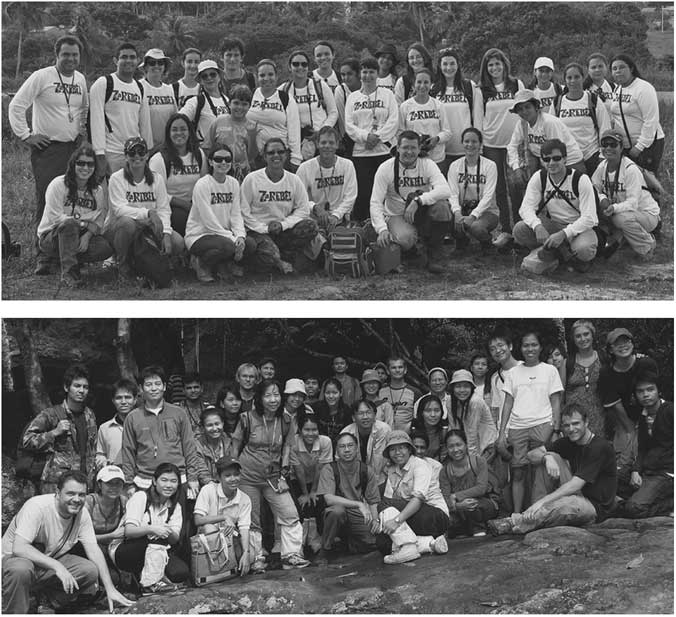In the past two decades, the taxonomy and systematics of tropical lichens have received increased attention. Tropical lichen biotas are dominated by crustose microlichens, particularly Arthoniaceae, Caliciaceae, Graphidaceae, Lecanoraceae, Malmideaceae, Opegraphaceae, Pertusariaceae, Porinaceae, Pyrenulaceae, Ramalinaceae, Roccellaceae, and Trypetheliaceae (Cáceres Reference Cáceres2007; Rivas Plata et al. Reference Rivas Plata, Lücking and Lumbsch2008; Lücking et al. Reference Lücking, Rivas-Plata, Chavez, Umaña and Sipman2009). Whereas Graphidaceae, by far the largest family, are by now relatively well-known (Staiger Reference Staiger2002; Frisch et al. Reference Frisch, Kalb and Grube2006; Rivas Plata et al. Reference Rivas Plata, Lücking and Lumbsch2012) and identification tools exist for families such as Malmideaceae and Pyrenulaceae (Aptroot Reference Aptroot2012; Breuss & Lücking Reference Breuss and Lücking2015), most have no comprehensive treatments available.
Here, we present a first attempt at a global revision of Trypetheliaceae, the second most important component in tropical regions after Graphidaceae. In analogy to the latter, generic concepts in Trypetheliaceae were long based on ascoma organisation and ascospore septation, resulting in artificial entities. Molecular phylogenetic studies contributed to a more natural generic concept, with surprising results and dramatic changes. While the number of genera now recognized remained almost unchanged, the inclusion of species previously classified in Arthopyrenia and Mycomicrothelia in the family and the fusion of Astrothelium, Campylothelium, Cryptothelium, and the bulk of species previously classified in Trypethelium, into what is now recognized as a single, megadiverse genus Astrothelium, is in stark contrast with the previous classification and delimitation of Trypetheliaceae.
Globalization has long entered the scientific world and the combination of different expertise with broad geographic coverage makes it possible to cover a taxon from every possible angle, bringing together traditional taxonomy, type studies, and nomenclature, with molecular phylogenetics and other quantitative tools. The core of this work is based on long ongoing taxonomic revisions of pyrenocarpous groups by the first author, a comprehensive molecular phylogeny enthusiatically assembled by M.P. Nelsen as part of his PhD thesis work at the University of Chicago and The Field Museum, and ongoing inventories of tropical crustose microlichens spearheaded by both authors and H.J.M. Sipman, who placed numerous specimens at our disposal. Access to biodiversity in tropical areas, facilitated through international collaborations, has been crucial and also resulted in the training of local students and professionals (Fig. 1). Another important component is the ongoing digitization of herbarium specimens, in particular types, through projects such the Global Plants Initiative [http://gpi.myspecies.info; https://plants.jstor.org], which made it possible to track down even some of the most obscure names and elucidate their status. Last but not least, the outstanding editorial team of The Lichenologist helped to assemble this collaborative treatment into a special issue.

Fig. 1 REBEL meeting 2013 in northeastern Brazil (above). Many new taxa in Trypetheliaceae have been found in this area and in the Amazon and students shown here have participated in their discovery and publication. Thelotremataceae workshop 2008 in Thailand (below). Several of the students depicted there are now active, successful lichenologists and some have contributed to this work on Trypetheliaceae.
As a result, this issue contains nine contributions from 46 authors representing 26 countries. In the first six papers (pp. 609–737), 136 new species of Trypetheliaceae are described from different tropical areas, focusing on the Neotropics and the eastern Palaeotropics. Many are based on phylogenetic studies, and the work by Luangsuphabool et al. (pp. 727–737) is a nice example of where detailed analysis in a small target group can reveal unexpected diversity. Lücking et al. (pp. 739–762) provide a much expanded phylogenetic framework for the family, based on the earlier study by Nelsen et al. (Reference Nelsen, Lücking, Aptroot, Andrew, Cáceres, Rivas Plata, Gueidan, Canêz, Knight and Ludwig2014), but with a focus on species-level clades. The family is revised synoptically by Aptroot & Lücking (pp. 763–982), with keys to genera and species, extensive synonymy, and brief descriptions for all taxa are cross-referenced to those introduced in the other papers. Finally, Aptroot et al. (pp. 983–994) predict that, with over 400 species now recognized, compared to approximately 200 in the latest Dictionary of the Fungi (Kirk et al. Reference Kirk, Cannon, Minter and Stalpers2008), the family might contain up to 800 species. Much work remains to be done!



